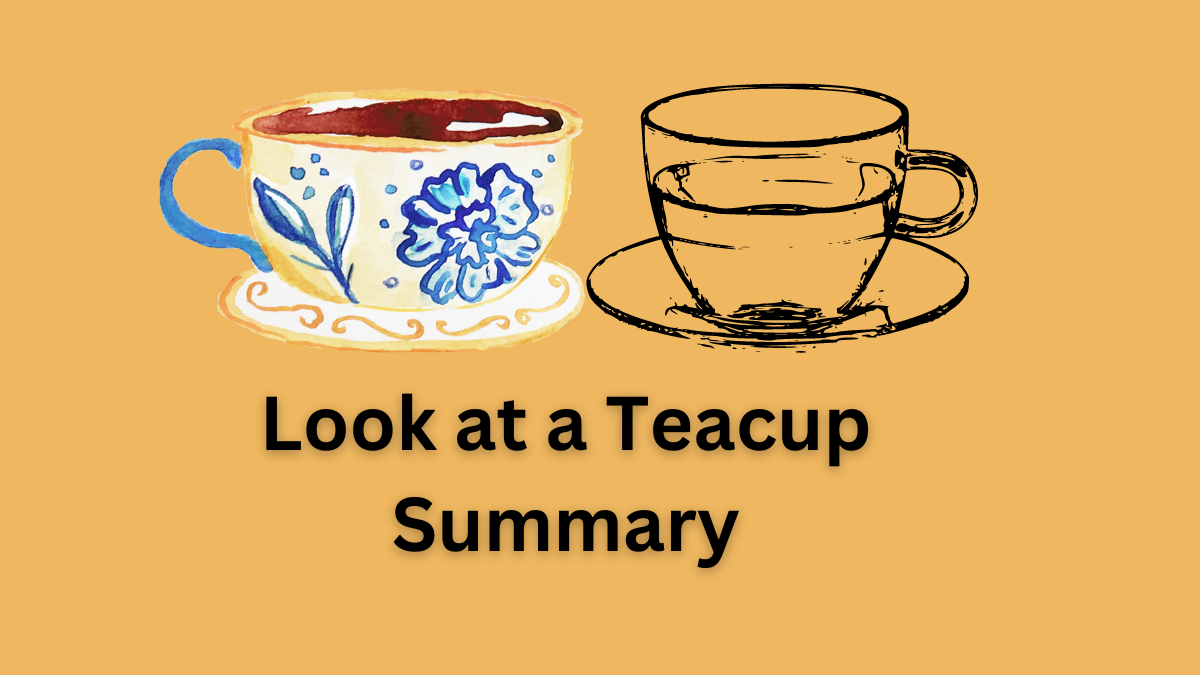Look at a Teacup Summary
In her essay “Look at a Teacup,” Patricia Hampl explores the profound connections between generations, history, and personal identity, using the symbol of a teacup.
Written in a narrative style, the essay delves into the relationship between Hampl and her mother, while also reflecting on the broader context of World War II and the feminist movement in America.
The essay centers on a teacup bought by Hampl’s mother in 1939, the year she got married and the Second World War began. This teacup, made in Czechoslovakia, is more than just a piece of china; it carries the weight of history and personal memories.
For Hampl’s mother, the teacup represents the beauty and stability of marriage and family, cherished values that she hoped to pass down to her daughter.
However, Hampl perceives the teacup differently. To her, it symbolizes not just family tradition, but also the devastation of the war and the subsequent shifts in societal norms. The essay contrasts the mother’s traditional views on marriage and family with Hampl’s modern, feminist perspective.
The war, which caused immense destruction, also triggered significant changes in how women viewed their roles in society. Many women began to see marriage and family as forms of oppression and sought greater independence and equality.
The essay is written in a stream-of-consciousness style, reflecting the fragmented nature of memory and emotion. Hampl’s thoughts and feelings flow freely, sometimes disjointedly, mirroring the chaos and disruption caused by the war. This style effectively conveys the complexity of her reflections on her mother’s life and the broader historical context.
Throughout the essay, Hampl uses vivid imagery and symbolism. The “falling flowers” inside the teacup represent the decline of cultural norms, while the “falling bodies” and “falling bombs onto women” evoke the human cost of the war. These images highlight the essay’s central themes of loss and transformation.
Read More: The House Call Summary
Ultimately, “Look at a Teacup” is about the connections between past and present, and between personal and historical narratives. The teacup serves as a bridge, linking Hampl to her mother and the turbulent events of the mid-20th century.
Through this simple object, Hampl explores how history shapes personal identity and how different generations interpret and value traditions. The essay reflects on the enduring impact of the past on the present and how individuals make sense of their heritage in a changing world.
Read More: “Fear” Summary and Important Questions/Answers
Important Questions and Answers
What is the significance of the teacup in the essay?
The teacup symbolizes the connection between past and present, as well as the relationship between Hampl and her mother. It represents family history, cultural heritage, and the impact of historical events like World War II on personal lives.
How does Hampl’s view on marriage and family differ from her mother’s?
Hampl’s mother values marriage and family as the most important aspects of life. In contrast, Hampl views these traditional roles critically, influenced by the feminist movement and the idea that marriage can be a form of oppression for women.
What role does World War II play in the essay?
World War II serves as a backdrop that significantly affects the characters and their perspectives. It brought destruction and changed societal norms, influencing the feminist movement and altering the roles and expectations of women, which is reflected in the differing views of Hampl and her mother.
Describe the style of the essay and its effect on the reader.
The essay is written in a stream-of-consciousness style, which mirrors the fragmented nature of memory and emotion. This style helps convey the complexity of Hampl’s reflections and makes the reader feel the chaos and disruption caused by the war and personal conflicts.
What are some of the symbolic meanings found in the essay?
The teacup itself is a central symbol, representing cultural heritage and family connections. “Falling flowers” symbolize the decline of cultural norms, while “falling bodies” and “falling bombs onto women” evoke the devastation of war and its impact on women’s lives. These symbols highlight the themes of loss, transformation, and the changing roles of women.
Read Next: My Heart Leaps Up When I Behold Summary
